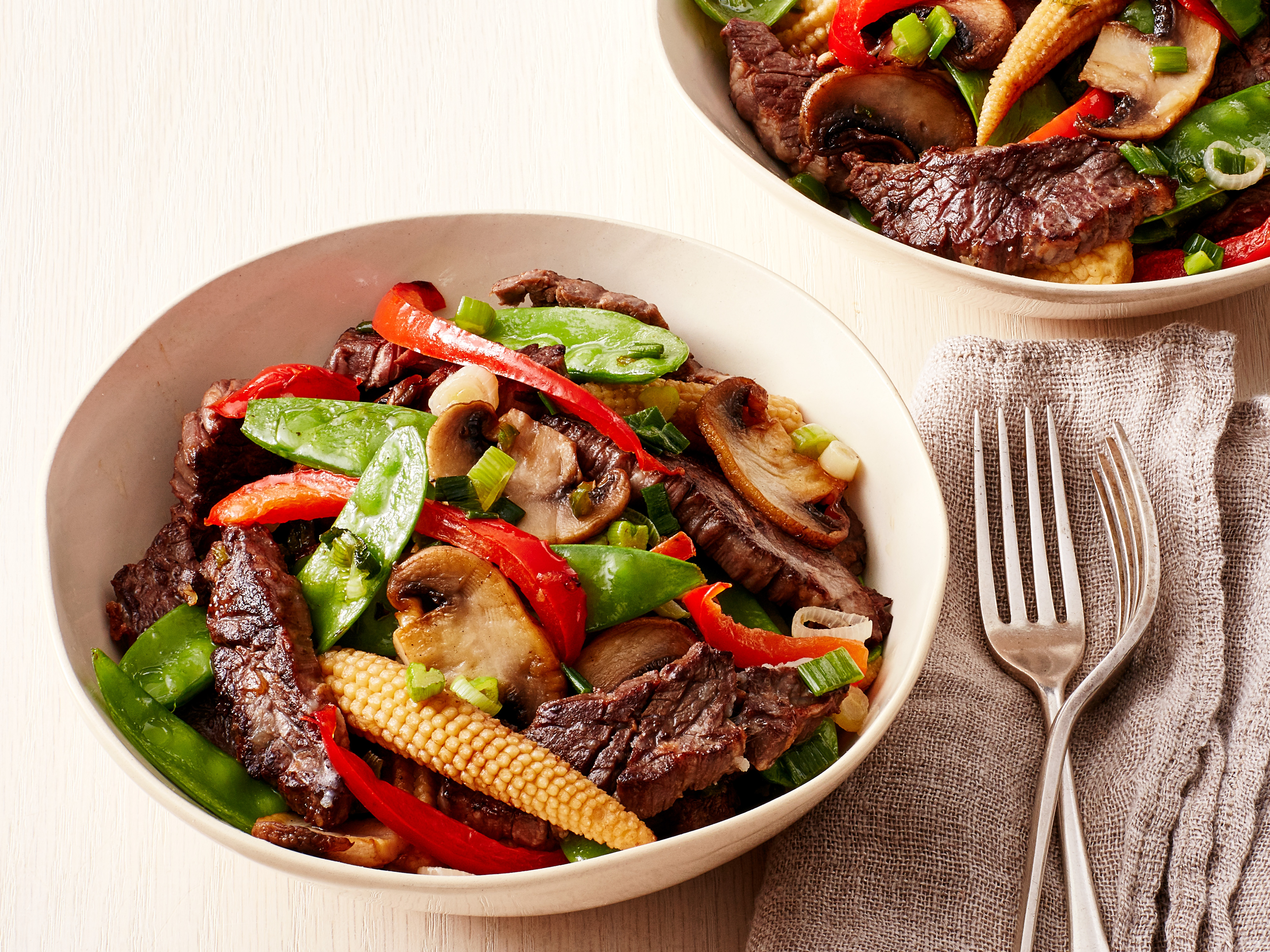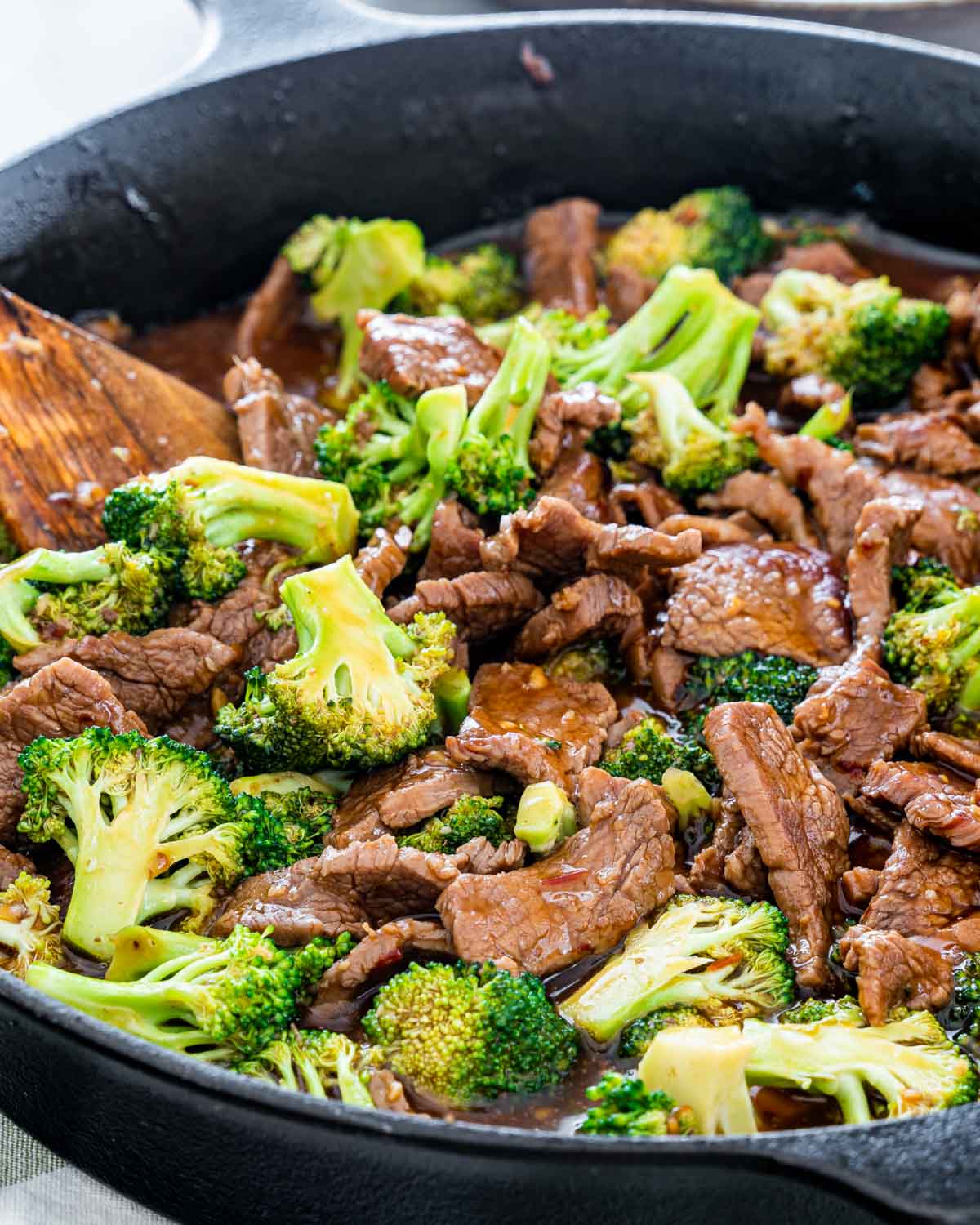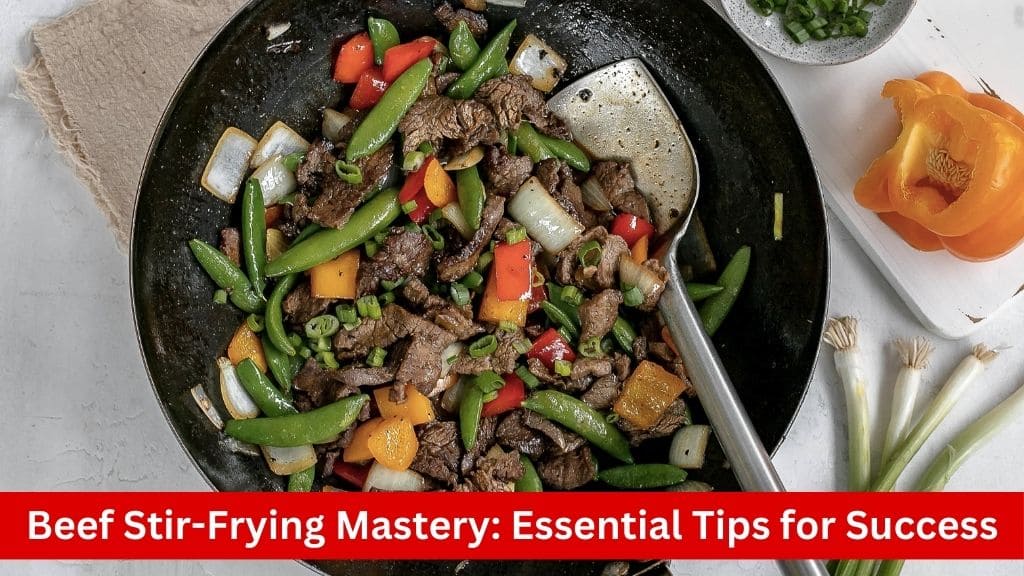Stir-frying beef is a culinary art form that balances flavors, textures, and cooking techniques to create a dish that’s both delicious and satisfying. Whether you’re a novice cook or a seasoned chef, mastering the art of stir-frying beef can elevate your home cooking to new heights. In this comprehensive guide, we’ll explore everything you need to know to stir-fry beef like a pro.
Stir-frying is a popular cooking method in Asian cuisine that involves quickly cooking ingredients in a hot pan or wok over high heat. This technique allows for the retention of nutrients, flavors, and textures while producing beautifully caramelized surfaces on the ingredients. When it comes to stir-frying beef, the key is to slice the meat thinly and cook it quickly to achieve tender, succulent results.
Why Stir-Fry Beef?
- Speed: Stir-frying is a fast and efficient cooking method, making it perfect for busy weeknights or when you need to whip up a meal in a hurry.
- Versatility: You can stir-fry beef with a wide range of vegetables, sauces, and seasonings, allowing for endless flavor combinations.
- Health Benefits: Stir-frying retains the nutritional value of the ingredients since they are cooked quickly at high heat, preserving vitamins and minerals.
Choosing the Right Cut of Beef

Flavor
Different cuts of beef offer varying levels of flavor intensity. Here’s a breakdown of some popular options:
- Flank Steak: This cut is prized for its rich, beefy flavor, making it an excellent choice for stir-frying. It absorbs marinades well and pairs beautifully with bold sauces and seasonings.
- Sirloin Steak: Sirloin steak offers a balanced flavor profile with a hint of sweetness and a robust beefy taste. It’s versatile enough to complement a wide range of stir-fry ingredients and sauces.
- Skirt Steak: Known for its intense beefy flavor, skirt steak adds depth and complexity to stir-fry dishes. It’s best cooked quickly over high heat to maintain its tenderness.
- Beef Chuck: While slightly less tender than other cuts, beef chuck is budget-friendly and offers a rich, hearty flavor. When thinly sliced against the grain, it can still yield delicious results in stir-fry dishes.
Tenderness
The tenderness of the beef can significantly impact the texture of your stir-fry. Here’s how different cuts measure up in terms of tenderness:
- Flank Steak: While flavorful, flank steak can be slightly chewy if not sliced thinly against the grain. However, it becomes tender when cooked quickly over high heat.
- Sirloin Steak: Sirloin steak is moderately tender and holds up well in stir-fry dishes. For optimal results, slice it thinly and against the grain to maximize tenderness.
- Skirt Steak: Skirt steak is known for its coarse texture but can be tender when sliced thinly and cooked briefly. Marinating the meat beforehand can also help tenderize it.
- Beef Chuck: Beef chuck is less tender compared to other cuts but can still be used in stir-fry dishes with proper slicing and cooking techniques. Removing any tough connective tissue before slicing can improve its tenderness.
Budget
Consider your budget when selecting the right cut of beef for stir-frying. While premium cuts like flank steak and sirloin steak offer excellent flavor and tenderness, they tend to be more expensive. On the other hand, budget-friendly options like beef chuck can deliver satisfying results at a lower cost, making them ideal for everyday cooking.
Preparing the Beef

Slicing Thinly
The key to tender beef in a stir-fry is to slice it thinly against the grain. Cutting against the grain shortens the muscle fibers, resulting in more tender meat. Here’s how to do it:
- Identify the Grain: Examine the beef to determine the direction of the muscle fibers, also known as the grain. The grain typically runs parallel lines along the meat.
- Slice Against the Grain: Using a sharp knife, slice the beef perpendicular to the grain into thin strips. Aim for slices that are about 1/4 to 1/2 inch thick, depending on your preference.
Marinating
Marinating the beef adds flavor and helps tenderize the meat, making it more succulent and delicious. Here’s how to marinate beef for stir-frying:
- Choose a Marinade: Prepare a marinade using ingredients like soy sauce, garlic, ginger, sesame oil, and rice wine. You can also add additional seasonings like chili flakes or brown sugar for extra flavor.
- Coat the Beef: Place the thinly sliced beef in a shallow dish or resealable plastic bag and pour the marinade over it, ensuring that the meat is evenly coated. Massage the marinade into the beef to ensure maximum flavor penetration.
- Marinate: Cover the dish or seal the bag and refrigerate the beef for at least 30 minutes to allow the flavors to infuse and the meat to tenderize. For even more flavor, marinate the beef for up to 24 hours in the refrigerator.
Velveting
Velveting is a technique used to further tenderize the beef and create a velvety texture. While optional, it can yield exceptionally tender results. Here’s how to velvet beef for stir-frying:
- Prepare the Velvetting Mixture: In a bowl, combine cornstarch, egg white, rice wine, and a pinch of salt. Whisk until smooth and well combined.
- Coat the Beef: Toss the thinly sliced beef in the velvetting mixture until evenly coated. Allow the beef to marinate in the mixture for about 15 to 30 minutes.
- Blanch or Stir-Fry: To velvet the beef, blanch it in boiling water for a few seconds until it turns opaque, then drain and rinse with cold water. Alternatively, you can stir-fry the beef in a small amount of oil until it’s just cooked through.
Essential Ingredients and Equipment

Ingredients
- Beef: 1 pound (approximately 450 grams) of beef sirloin, thinly sliced into 2-inch strips.
- Vegetables:
- 1 ½ cups (approximately 180 grams) of fresh broccoli florets.
- 1 red bell pepper, thinly sliced into matchsticks.
- 2 carrots, thinly sliced.
- 1 green onion, chopped.
- Aromatics: 1 teaspoon of minced garlic.
- Sauce: 2 tablespoons of soy sauce.
- Other Ingredients:
- 2 tablespoons of vegetable oil (for stir-frying).
- 2 tablespoons of sesame seeds, toasted (for garnish).
Equipment
- Wok or Skillet: A wok is the traditional cooking vessel for stir-frying, thanks to its wide, sloping sides that allow for even heat distribution and easy tossing of ingredients. However, a large skillet or frying pan can also be used for stir-frying if a wok is not available. Choose a pan with a flat bottom and high sides to prevent ingredients from spilling over during cooking.
- Sharp Knife: A sharp knife is essential for slicing the beef and vegetables thinly and evenly. A chef’s knife or santoku knife works well for this task.
- Cutting Board: Use a sturdy cutting board to safely chop and prepare your ingredients. Opt for a cutting board with a non-slip surface to prevent accidents during slicing and dicing.
- Mixing Bowl: Use a mixing bowl to combine the marinade ingredients for the beef and the sauce ingredients for the stir-fry. Choose a bowl large enough to accommodate all the ingredients and allow for easy tossing.
- Tongs or Spatula: Tongs or a spatula are essential tools for stirring and flipping the ingredients in the wok or skillet. Opt for heat-resistant tongs or a spatula with a long handle to prevent burns.
Steps for Perfect Stir-Fried Beef

1. Preparation
Before you start cooking, ensure that all your ingredients are prepped and ready to go. This includes:
- Slicing the Beef: Slice the beef thinly against the grain to maximize tenderness. Aim for slices that are uniform in thickness for even cooking.
- Chopping the Vegetables: Chop the vegetables into bite-sized pieces or julienne strips for quick and even cooking. Keep the vegetables separate to add them to the wok or skillet at the appropriate times.
- Mixing the Sauce: Combine the ingredients for the stir-fry sauce in a small bowl and set aside. Adjust the seasonings to taste, adding more soy sauce for saltiness, sweetness, or spice as desired.
2. Heating the Wok
Place a wok or large skillet over high heat until it becomes smoking hot. This step is crucial for achieving a good sear on the beef and vegetables and ensuring that they cook quickly and evenly.
3. Adding Oil
Add a small amount of high-heat oil to the wok or skillet and swirl to coat the surface evenly. The oil helps prevent sticking and promotes caramelization, imparting flavor to the ingredients.
4. Stir-Frying the Beef
- Sear the Beef: Add the sliced beef to the hot wok or skillet in a single layer, allowing it to sear without stirring for a minute or two. This step helps develop a caramelized crust on the meat.
- Stir-Fry Until Browned: Once the beef is seared on one side, use tongs or a spatula to flip the slices and stir-fry until they are browned but still slightly pink in the center. Be careful not to overcook the beef, as it can become tough and dry.
5. Cooking the Vegetables
- Add Aromatics: Push the seared beef to one side of the wok or skillet and add the minced garlic, ginger, and sliced green onions to the empty space. Stir-fry briefly until fragrant, taking care not to let the aromatics burn.
- Add Vegetables: Add the chopped vegetables to the wok or skillet, spreading them out in an even layer. Stir-fry the vegetables until they are crisp-tender but still vibrant in color. Avoid overcooking, as this can result in mushy vegetables.
6. Combining and Saucing
- Mix Everything Together: Once the vegetables are cooked to your liking, return the seared beef to the wok or skillet, combining it with the vegetables. Toss everything together to ensure that the beef and vegetables are evenly distributed.
- Pour in the Sauce: Pour the prepared stir-fry sauce over the beef and vegetables, stirring continuously to coat them evenly. The sauce will thicken slightly and cling to the ingredients, adding flavor and moisture to the dish.
7. Serving
Garnish Serve: Transfer the stir-fried beef and vegetables to a serving platter and garnish with sesame seeds, chopped green onions, or fresh herbs for added flavor and visual appeal. Serve hot with steamed rice or noodles.
Tips for Success

Preheat Properly: Before adding any ingredients, ensure that your wok or skillet is thoroughly heated over high heat. A hot pan ensures that the beef and vegetables sear quickly, locking in their juices and flavors.
Cook in Batches if Necessary: Overcrowding the pan can cause the ingredients to steam rather than sear, resulting in a less flavorful stir-fry. If your pan is too small, cook the beef and vegetables in batches to maintain high heat and proper searing.
Constant Tossing and Stirring: Continuously toss and stir the ingredients in the wok or skillet to ensure even cooking and prevent sticking or burning. This also helps distribute the heat evenly, resulting in uniformly cooked beef and vegetables.
Taste and Adjust: After adding the stir-fry sauce, taste the dish and adjust the seasonings as needed. You can add more soy sauce for saltiness, sweetness, or spice according to your preferences. Don’t be afraid to customize the flavors to suit your taste.
Be Creative: Don’t hesitate to experiment with different combinations of ingredients, sauces, and seasonings to create unique and delicious stir-fry dishes. Try adding additional vegetables, herbs, or spices to customize the dish to your liking.
Thinly Slice the Beef: Slicing the beef thinly against the grain ensures tenderness and promotes quick cooking. Aim for uniform slices to ensure even cooking and consistent texture throughout the dish.
Use the Right Oil: Choose a high-heat oil with a neutral flavor, such as vegetable oil, canola oil, or peanut oil, for stir-frying. These oils have a high smoke point, which prevents them from burning and imparting off-flavors to the dish.
Balance Flavors and Textures: Aim for a balance of flavors and textures in your stir-fry dish. Incorporate a variety of vegetables for color, crunch, and nutrition, and ensure that the sauce is well-balanced in terms of saltiness, sweetness, acidity, and umami.
Conclusion
Stir-frying beef is a simple yet rewarding cooking technique that yields flavorful and nutritious meals in minutes. By following these tips and techniques, you’ll be able to stir-fry beef like a pro and impress your family and friends with your culinary skills. So grab your wok or skillet, slice up some beef, and get ready to stir-fry your way to deliciousness!


